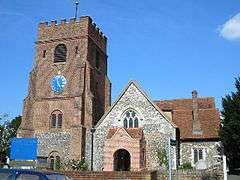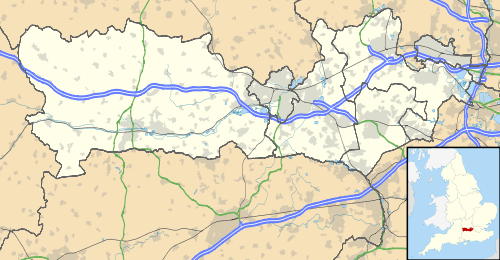Langley, Berkshire
Langley, also known as Langley Marish, is a large village in the unitary authority of Slough in South East England. It is two miles (3 km) east of central Slough, with which it is contiguous, and 18 miles (29 km) west of Charing Cross in Central London. Langley is located in the historic county of Buckinghamshire.
| Langley | |
|---|---|
 St Mary the Virgin parish church | |
 Langley Location within Berkshire | |
| Area | 3.6 km2 (1.4 sq mi) |
| Population | 17,583 [1] |
| • Density | 4,884/km2 (12,650/sq mi) |
| OS grid reference | TQ005795 |
| Unitary authority | |
| Ceremonial county | |
| Region | |
| Country | England |
| Sovereign state | United Kingdom |
| Post town | Slough |
| Postcode district | SL3 [2] |
| Dialling code | 01753 |
| Police | Thames Valley |
| Fire | Royal Berkshire |
| Ambulance | South Central |
| UK Parliament | |
| Website | Langley Village |
Etymology
The place-name Langley derives from two Middle English words: lang meaning long and leah, a wood or clearing. Langley was formed of a number of clearings: George Green, Horsemoor Green, Middle Green, Sawyers Green and Shreding Green. They became the sites for housing which merged into one village centred on the parish church in St Mary's Road. The clearings are remembered in the names of streets or smaller green fields.
Marish or Maries commemorates Christiana de Marecis who held the manor for a short time in the reign of Edward I.[3]
History
Notable buildings
The Church of St Mary the Virgin is in the Church of England diocese of Oxford. The church is a Grade I listed building[4] and houses the Kedermister Library, given by Sir John Kedermister (or Kederminster), who also endowed the surviving almshouses of 1617 in the village. Other surviving almshouses include the Seymour Almshouses (1679–1688), given by Sir Edward Seymour who was a Speaker of the House of Commons, and those founded in 1839 by William Wild in Horsemoor Green.
Sir John Kedermister's house, Langley Park (bought by Charles Spencer, 3rd Duke of Marlborough) was demolished and rebuilt to designs by Stiff Leadbetter, starting in 1756 and completed in the year of his death, 1758.[5]
Langley Hall was built in the 17th century, but the façade was added in the 18th. In the early part of the 20th century it housed a preparatory school for boys and was known as Langley Place.[6] The Hall then served as the Actor's Orphanage,[7] and was used by RAF Bomber Command during World War II, then by the Road Research Laboratory, Langley College and East Berkshire College.[6]
Langley Hall was purchased by the government in June 2011 to become one of the country's first Free Schools. Langley Hall Primary Academy opened in September 2011 for children aged 4 to 11.
The Langley Academy secondary school opened in 2008 and was designed by architects Foster + Partners.
Langley Airfield
The Hawker Aircraft Company bought Parlaunt Farm at Langley in 1938 and built a major factory and airfield there. Over 9,000 military aircraft were manufactured at the site especially the Hurricane during World War II and also the Tempest and Sea Fury. The final Hurricane built (a MkIIC serialled PZ865, which still flies today with the Battle of Britain Memorial Flight) was completed here on 27 July 1944 and named 'Last of The Many' in a special ceremony. Retiring Chief Test Pilot P W S 'George' Bulman made the first flight of this the aeroplane on this occasion – he having made the first flight of the prototype from Brooklands almost nine years earlier.
The Hawker Tornado (1940), Typhoon (1940), Tempest (1942), Fury (1944), Sea Fury (1945), and the General Aircraft Hamilcar X tank-carrying glider (1945) all made their first flights from Langley. Postwar, the aerodrome was also used by Airwork Services and British South American Airways for aircraft maintenance work.
The Hawker factory closed in 1958 having also manufactured Hawker Hunter fighters and earlier jet prototypes. Production and staff were transferred to the flight test airfield at Dunsfold Aerodrome and the parent Hawker factory in Kingston-on-Thames (now Kingston upon Thames), both in Surrey. Little of the factory or airfield remain today although the area's aviation past is remembered in street-names such as Spitfire Close and Hurricane Way. A marker stone was unveiled by the Airfields of Britain Conservation Trust on 5 October 2019.
Ford
The Ford Motor Company opened a commercial vehicle component factory at Langley Airfield in 1949, and then bought the entire site from Hawker Siddeley in 1959. The former aircraft factory was re-used for commercial vehicle manufacture and the Ford Transit was built here until production was transferred to Ford's Southampton plant at Swaythling, Southampton, and later the Ford Cargo. The Langley factory became part of Iveco in 1986 but finally closed in September 1997. Demolished a year later by Gregory Demolition, the site is now redeveloped with new housing, offices and warehousing (including Royal Mail's International Mail Centre, which services nearby Heathrow Airport).
Miscellaneous
Langley Carnival is held annually on the second Saturday in July at the Langley Park Memorial Recreation Ground.
The Cable Corporation, based at Langley, was the first cable company in the world to offer voice, video and data services to business and residential users.
The first volume of writer Charles Tyrie's autobiography is titled The Langley Boy; Tyrie grew up in Langley in the 1940s and 1950s. ISBN 1-4259-6403-6 / ISBN 978-1-4259-6403-0
Langley is reputed to be haunted by a ghost in a yellow coat.[8]
Transport
Langley railway station, which includes an Isambard Kingdom Brunel period building, is on the Great Western Main Line to London Paddington. Great Western Railway operate a half-hourly service in each direction. From 2019, it will become part of the Elizabeth line with services operated by TfL Rail. Due to the addition of the Elizabeth line, the station is being upgraded to include three new lifts along with a new ticket hall, new ticket office and new ticket gates.
In July 2012, The Department of Transport announced plans to build the Western Rail Approach between Langley and Iver Stations.
Notable people
- Poet John Milton (1608–74) is said to have lived for a time near Kedermister Library in Langley[9][Questioned – see talk page.]
- World War I war artist Paul Nash (1889–1946) is buried in the churchyard of St. Mary's Church, Langley
- Writer John Pudney (1909–77) – who wrote one of the best-known poems of the Second World War, For Johnny – was born in Langley
- Nathaniel Vincent (1639?–97), nonconformist minister and writer, lived in Langley after the Restoration (he was ejected in 1662)
Nearest places
Richings Park
References
- Key Statistics; Quick Statistics: Population Density United Kingdom Census 2011 Office for National Statistics Retrieved 31 October 2014
- "Cybo". Cybo.
- Langley Village history Hornby, James John (1895). Walks Round About Eton. p. 18.
- "The Church of St. Mary the Virgin, Langley Marish. (Grade I Listing)". Slough Museum. Archived from the original on 4 July 2008. Retrieved 26 April 2010.
- A domed temple in the park, c. 1740, attributed to Roger Morris, no longer exists; Colvin, H.M. (1997) [1954]. A Biographical Dictionary of British Architects, 1600–1840 (3rd ed.). New Haven: Yale University Press. ISBN 0-300-07207-4.: s.v. "Leadbetter, Stiff", "Morris, Roger".
- "langleyvillage.co.uk". www.langleyvillage.co.uk.
- Fraser 1973, p. 148.
- Ash, Russell (1973). Folklore, Myths and Legends of Britain. Reader's Digest Association Limited. p. 267. ISBN 9780340165973.
- "langleyvillage.co.uk". www.langleyvillage.co.uk.
Sources and further reading
- Fraser, Maxwell (1973). The History of Slough. Slough: Slough Corporation. p. 148.CS1 maint: ref=harv (link)
- Mason, Francis K (1991). Hawker Aircraft Since 1920 (3rd revised ed.). London: Putnam. ISBN 0-85177-839-9.CS1 maint: ref=harv (link)
- Page, W.H., ed. (1925). A History of the County of Buckingham, Volume 3. Victoria County History. pp. 294–301.CS1 maint: ref=harv (link)
- Pevsner, Nikolaus (1960). Buckinghamshire. The Buildings of England. Harmondsworth: Penguin Books. pp. 181–183. ISBN 0-14-071019-1.CS1 maint: ref=harv (link)
- Pudney, John (1955). Six Great Aviators – A V Roe; Alcock & Brown; Lindbergh; Kingsford-Smith; Saint-Exupery; Neville Duke. Hamish Hamilton.CS1 maint: ref=harv (link)
- Shaw, Stuart (July 2000). "The History of Langley Aircraft Factory and Airfield". Airfield Review: 17–19.
- "Langley Marish Buckinghamshire". visionofbritain.org.uk. Retrieved 1 May 2016.
External links
- Langley Village website
- "History of Langley park". Buckinghamshire County Council. Archived from the original on 26 February 2014. Retrieved 8 March 2014.